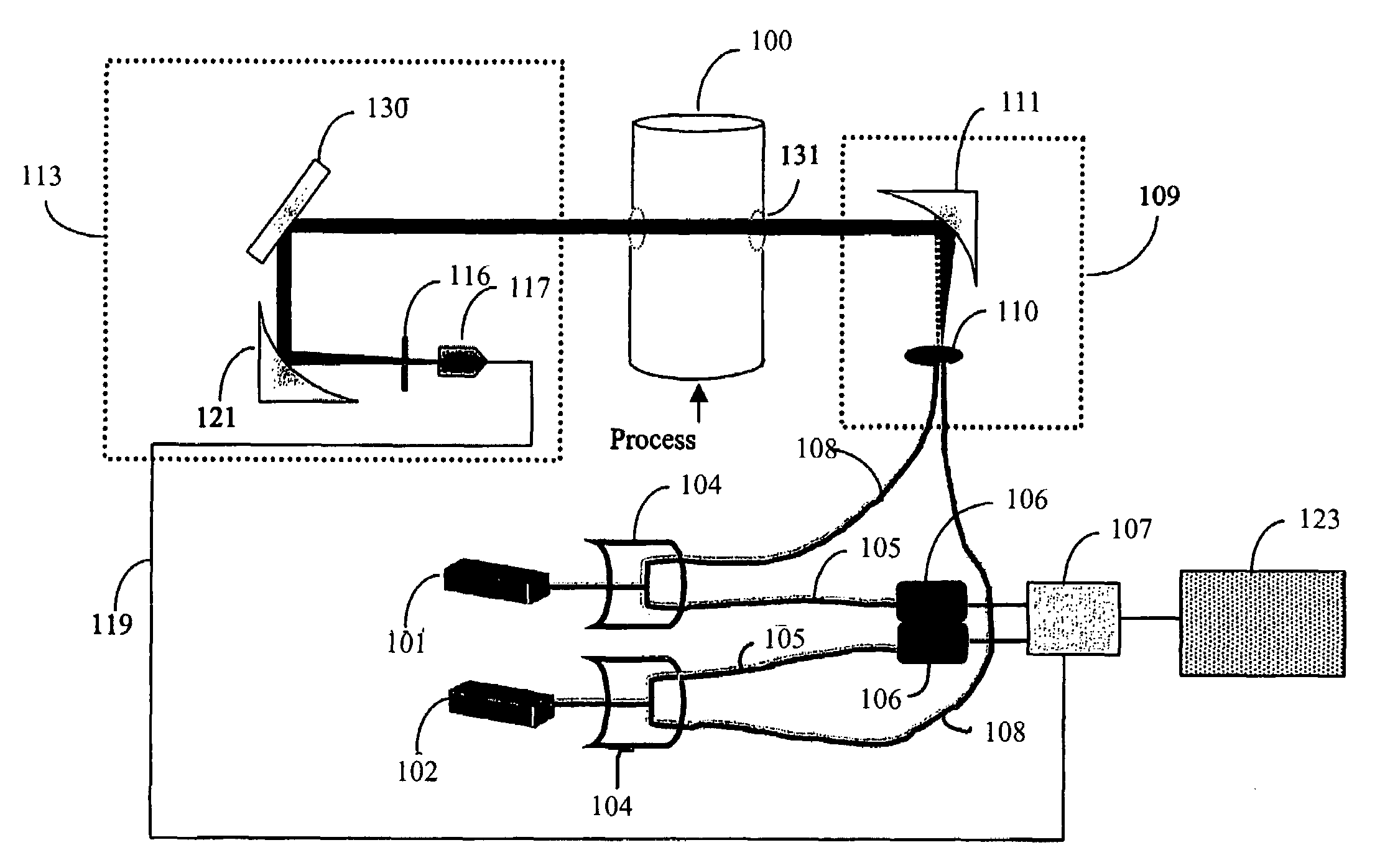Apparatus and methods for launching and receiving a broad wavelength range source
a wavelength range, antenna technology, applied in the direction of optical radiation measurement, lighting and heating apparatus, instruments, etc., can solve the problems of reducing the effect of delay time, reducing the range of sampling delay times, and not being able to use true in-situ probes for monitoring both osub>2 /sub>and co, etc., to enhance the overall robustness of optical beam transport
- Summary
- Abstract
- Description
- Claims
- Application Information
AI Technical Summary
Benefits of technology
Problems solved by technology
Method used
Image
Examples
example 1
[0069]Using the receiver module illustrated in FIG. 8, sample sets of data were collected from an industrial 30 MW furnace installation and on a 500 kW pilot furnace. For the industrial furnace, the beam launch system illustrated in FIG. 6 was employed with a 48 foot (14.6 meters) pathlength across the process to the receiver module. In this case, O2 and H2O were detected in the process by scanning a diode laser at 200 Hz over a wavelength range to collect the full lineshape. A detailed description of the monitoring methodology is described in assignee's copending published patent application 20020031737, Ser. No. 09 / 964,017, published Mar. 14, 2002, incorporated herein by reference. The resulting absorbance spectrum for O2 monitoring is illustrated in FIG. 9, with absorbance defined as
A=ε1c
Where A is the absorbance, ε is the absorptivity, 1 is the pathlength, and c is the concentration of the species being monitored. This relationship comes directly out of Beer's Law. The raw data ...
example 2
[0070]An example illustrating simultaneous H2O concentration, gas temperature and CO concentration from a 500 kW pilot furnace is illustrated in FIG. 11, with the raw data listed in Table 4. In this example, the furnace pathlength as only 1 foot (30.5 cm) and no O2 was present. (Note, the spectral region and simultaneous detection of H2O and CO in this region is discussed in assignee's U.S. Provisional Application No. 60 / 349,638, filed Jan. 17, 2002, incorporated herein by reference. In this example, the gas temperature was 1387 K based on the H2O peaks A and B resulting in a CO concentration of 4.7%. In addition, the H2O concentration based on peak A, 36.6% for this example can also be obtained.
[0071]Examples 1 and 2 illustrate the multi-species detection capabilities of the apparatus of the invention under industrial operating conditions where high levels of background radiation are present, strong thermal gradients are present resulting in the beam spatial position changing in ti...
PUM
| Property | Measurement | Unit |
|---|---|---|
| time | aaaaa | aaaaa |
| diameter | aaaaa | aaaaa |
| diameter | aaaaa | aaaaa |
Abstract
Description
Claims
Application Information
 Login to View More
Login to View More - R&D
- Intellectual Property
- Life Sciences
- Materials
- Tech Scout
- Unparalleled Data Quality
- Higher Quality Content
- 60% Fewer Hallucinations
Browse by: Latest US Patents, China's latest patents, Technical Efficacy Thesaurus, Application Domain, Technology Topic, Popular Technical Reports.
© 2025 PatSnap. All rights reserved.Legal|Privacy policy|Modern Slavery Act Transparency Statement|Sitemap|About US| Contact US: help@patsnap.com



